Small Churches in Walk I
Oratorio del Buon Gesù (1561)
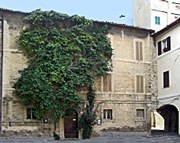
Giovanni Battista Vitelli (1538-1621) founded this oratory in 1561 on the model of that of St Philip Neri in Rome for a new confraternity, the Confraternita del Buon Gesù. The oratory was built on the site of the ancient Ospedale di San Feliciano and an earlier church that was dedicated to the Immaculate Conception. The local historian, Ludovico Jacobilli (1598-1664) was among its members.
The oratory was damaged in the bombardment of 1944:
-
✴its altarpiece of the Immaculate Virgin (17th century) by Andrea Sacchi was destroyed; and
-
✴the remains of Giovanni Battista Vitelli and the inscription from his damaged monument were transferred to Cappella Jacobilli, in the left transept of the Duomo.
The building now houses now the Centro Sportivo Italiano.
San Leonardo (12th century)
This church, which was first documented in 1212, when Bishop Egidio ceded it to the monastery of San Stefano di Gallano. It was destroyed in the bombardment of 1943.
Madonna del Pianto (17th century)
This venerated statue as first recorded in 1647. Its veneration became marked in 1703, when Foligno escaped the worst effects of an earthquake that happened on the feast of the Madonna del Pianto (January 14th). The statue was taken in procession for the first time some two weeks later. The chapter of St Peter's, Rome paid for a crown of gold in 1713, and Archbishop Giovanni Maria Mastai Ferretti of Spoleto (later Pope Pius IX) paid for the decoration of the niche in which the statue was kept in ca. 1830.
The statue survived the bombardment of 1944 and was subsequently moved to the high altar of Sant’ Agostino. It is kept behind a screen there that is lifted each year on the Sunday nearest to January 14th.
The statue represents the richly clothed Madonna and Child, seated on an elaborate gilded wooden throne. The present throne is a modern copy of the original, which was destroyed in the bombardment.
St Leonard (early 18th century)
This panel by Giuseppe Nicola Nasini was destroyed, like the church itself, in the bombardment of the Second World War.
Works by Tommaso Nasini
Three documented works by Tommaso Nasini were destroyed, like the church itself, in the bombardment of the Second World War:
-
✴two angels (1725); and
-
✴oval panels (1740), depicting:
-
•the Birth of the Virgin; and
-
•the Assumption of the Virgin.
Santa Maria della Croce (1286)
This church and Augustinian nunnery stood beside a Porta della Croce, at what is now the junction of Via Umberto I and Via Oberdan.
The nunnery was suppressed in the Napoleonic era. It was re-opened early in the 19th century, when it merged with two nunneries in Via dei Monasteri: Santa Maria di Betlem and Sant’ Elisabetta.
[When was it demolished?]
Santa Maria della Consolazione (1581)
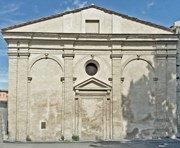
This church was built to house a miraculous fresco of the Madonna and Child. It was closed in 1921. In his book “Foligno e la Madonna”, Father Michele Faloci-Pulignani recorded that he saw the fresco for the last time on 17th July, 1921. When he returned the following day, the doors of the church were open and the fresco had disappeared. The exterior of the church has recently been restored.
Santa Maria Maddalena (13th century)
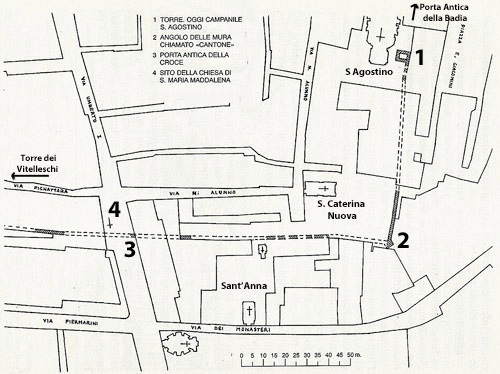
From Vladimiro Cruciani, Figure 15
According to Ludovico Jacobilli (quoted by Guerrini and Latini, referenced below, at p. 110, note 433):
-
“In times gone by, the church [of Santa Maria Maddalena, which is now in Via Umberto I] was next to the city gate known as ‘della Croce’ [later, the Porta Antica della Croce], from which one travelled to Rome. ... today, only vestiges of this gate remain, between the secondary entrance to [Santa Maria Maddalena] and the walls of the orchard of the nunnery of Sant’ Anna” (my translation).
The plan above shows the site of the Porta Antica della Croce (3), near the site of church of Santa Maria Maddalena (4) and the junction of Via Pignattara and Via Umberto I.
This church was documented in the “sentenza” of Cardinal Ranieri Cappoci of 1239, as a possession of the Abbazia di Sassovivo. Although there is no documentary evidence, tradition has it that Giuseppe Piermarini (died 1808) was buried here. This church was destroyed in the earthquake of 1832.
-
✴Two carved lions (13th century) from the entrance are now displayed in the ticket office of Palazzo Trinci, which forms part of the Museo Archeologico (Room 3) They were carved from stone that bears a Roman inscription (1st century AD).
-
✴After the earthquake, the faithful still braved the perils of the ruined church each 10th July to venerate a fresco (15th century ?) known as the Madonna del Riscatto. Bishop Nicolò Belletti decided to move it to the the Oratorio di Madre Paola (now Santa Caterina Nuova) in 1853.
Small Churches in Walk II
San Giovanni dell’ Acqua (13th century)
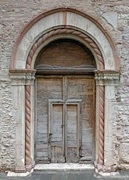
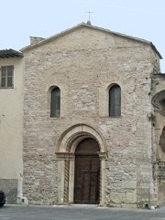
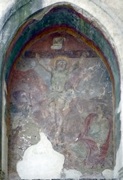
According to Raffaella Stanzione (referenced below, at p. 141) San Giovanni dell’ Acqua was documented in 1138, when Pope Innocent II confirmed it as a possession of Bishop Benedetto of Foligno. This was probably the “ecclesia di S. Jovannis de Aqua” that was documented in 1239 in the “sentenza” of Cardinal Ranieri Capocci.
The original church had two naves. In 1776, the nave on the right was remodelled to form the present church. The other nave, which became the sacristy, preserves some of its original frescoes (14th and 15th centuries), illustrated in this page of the Foligno branch of Archeoclub d’ Italia. The elegant portal of the church also survives.
A fresco (15th century) of the Crucifixion in an aedicule on the right wall (in Via delle Ceneri), has recently been restored.
Santa Maria delle Grazie (1898)
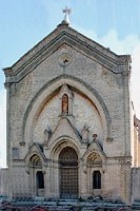
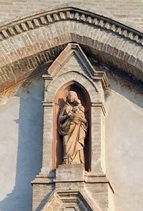
Bishop Luca Borsciani Cibo, who was a Servite and thus dedicated to the cult of the Virgin, arranged for the building of the first oratory here to house a miraculous terracotta image of the Madonna and Child (ca. 1400).
A new church was built on the site in 1603.
Vincenzo Benvenuti designed the current church, which replaced it in 1898. The statue mentioned above is preserved in an aedicule on its facade.
Santa Margherita alle Conce (1722-33)
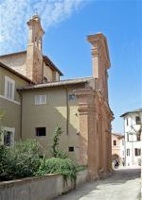
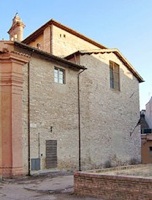
According to Paola Guerrini and Francesca Latini (referenced below, at pp. 309-10, entry 92) Ludovico Jacobilli recorded that Bishop Egidio degli Atti founded this church in 1208, and that it was included in the “sentenza” of Cardinal Ranieri Capocci in 1239 as a possession of the diocese of Foligno.
The church is also known as the Oratorio di San Giuseppe or della Trinità, because it was transferred to these two confraternities in 1616. It had originally faced the Canale dei Molini, but was reoriented during a major remodelling in 1722-33. (The original facade can be seen in the photograph on the right).
Santa Margherita was badly damaged in the earthquake of 1997 and has only recently re-opened after its restoration.
Interior
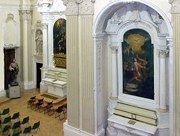
Holy Family (19th century)
This altarpiece on the high altar is by Mariano Piervittori.
San Tommaso dei Cipischi (1190)
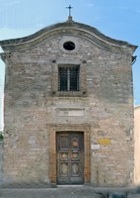

This church derives its name from that of the locality (Rione Cipischi). The inscription above the entrance records that it was consecrated in 1190 by Bishop Anselmo degli Atti (1155-1201). It was documented again in the “sentenza” of Cardinal Ranieri Cappoci of 1239, as a possession of the Abbazia di Sassovivo.
The interior was remodelled in the 18th century.
The church was de-consecrated in 1955.
Read more:
P. Guerrini and F. Latini, “Foligno: Dal Municipium Romano alla Civitas Medievale: Archeologia e Storia di una Città Umbra”, (2012) Spoleto
R. Stanzione,”Per la Storia dell' Architettura Romanica nell' Antica Diocesi di Foligno”, Bollettino Storico della Città di Foligno, 14 (1990) 119-43
Return to the page on Monuments of Foligno.
Return to Walk I: Oratorio del Buon Gesù, San Leonardo;
Santa Maria della Consolzione; Santa Maria della Croce; Santa Maria Maddalena
Return to Walk II: San Tommaso dei Cipischi;
San Giovanni dell’ Acqua; Santa Maria delle Grazie; Santa Margherita alle Conce.



